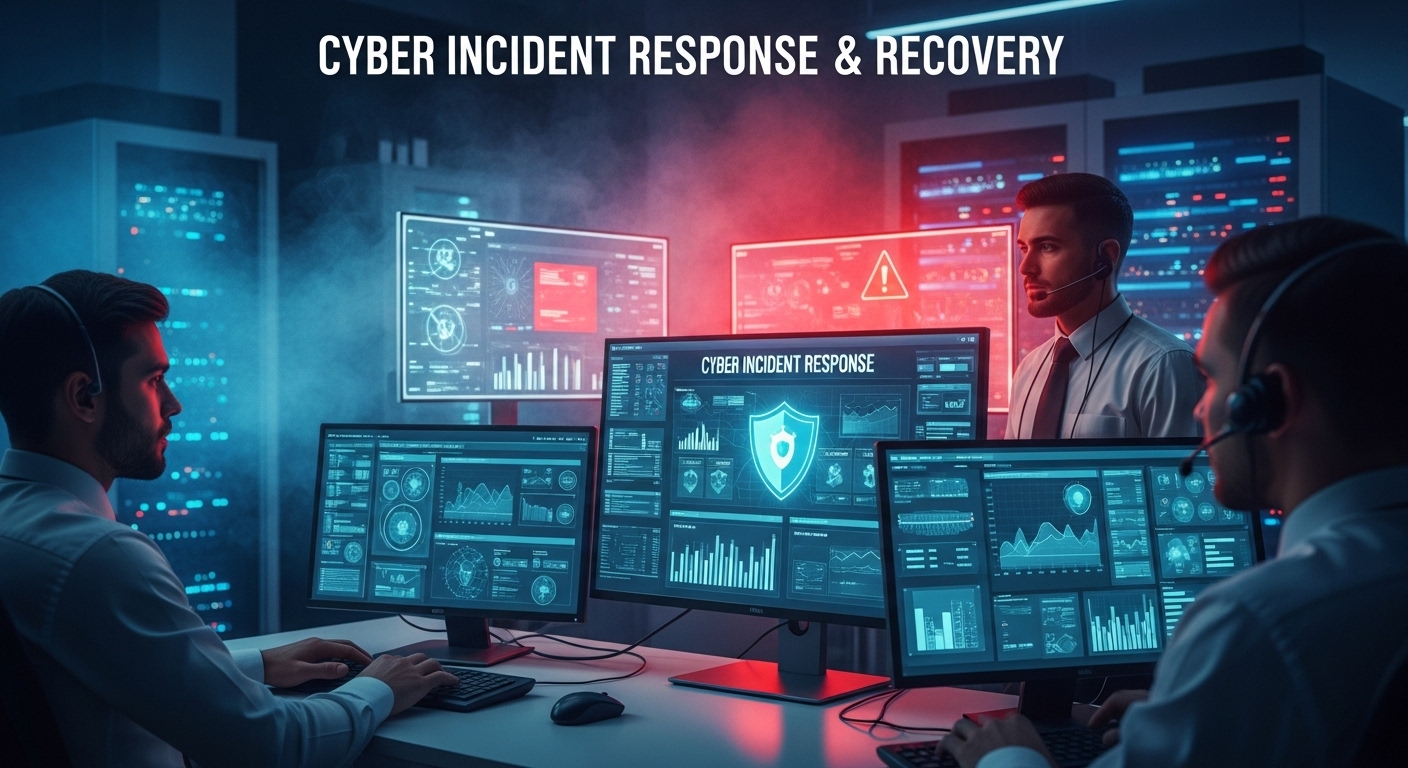
Small Business Guide to Cyber Incident Response & Recovery
Small Business Guide to Cyber Incident Response & Recovery
Every small business believes a cyber-attack won’t happen to them — until it does.
The first sign is often quiet: a strange login, a defaced page, or a sudden email flood. Then comes panic — the website’s offline, customer data is leaking, and Google has blacklisted the domain.
In that moment, one truth becomes clear: you don’t rise to the occasion — you fall to your level of preparation.
For SMEs, a cyber incident can erase months of growth. Yet, with a well-structured Incident Response and Recovery Plan, you can transform disaster into resilience — minimizing damage, preserving trust, and even improving your long-term cybersecurity posture.
ALSO, READ How SMEs Achieved SEO Growth with Smart Security
This guide explains, step by step, how small businesses can detect, contain, and recover from cyber incidents — the same framework we use at 24SevenHub to secure client infrastructure across Africa and beyond.
1. What Is Cyber Incident Response?
Cyber Incident Response (CIR) is the structured process of preparing for, detecting, analyzing, containing, and recovering from security incidents that threaten digital assets.
An incident could include:
- Website defacement or unauthorized access
- Malware or ransomware infection
- Data breach or credential leak
- Phishing compromise of employee accounts
- Denial-of-Service (DoS) attacks
The goal isn’t just to fix what’s broken — it’s to understand what happened, limit its impact, and prevent recurrence.
2. Why Incident Response Matters for SMEs
Many SMEs think incident response is an “enterprise-only” concern. That’s a dangerous myth.
2.1 Attackers Target Small Businesses by Default
Automation has changed everything — bots now scan every IP, every CMS, every open port.
The 2025 Verizon Data Breach Report found that 46% of global breaches involved small organizations.
2.2 The Real Cost of a Breach
- Financial: Average recovery cost for SMEs = $120,000 (IBM 2025).
- Reputation: Customers rarely return after data exposure.
- Downtime: 60% of small businesses close within six months of a major cyberattack (US SBA).
Incident response isn’t a luxury — it’s digital survival.
3. The 6 Phases of Incident Response
A resilient response plan follows six phases, adapted from the NIST 800-61 framework.
3.1 Preparation
Build defenses before the breach.
- Maintain updated security policies.
- Train employees on phishing awareness.
- Implement endpoint protection & MFA.
- Schedule backups and test restoration.
- Pre-define your incident response team and escalation hierarchy.
Tools: Microsoft Defender 365, Cloudflare WAF, Sucuri Scanner, Bitwarden, UpdraftPlus.
3.2 Identification
Detect the incident early — minutes matter.
Look for red flags:
- Sudden traffic spikes or server overloads
- Unfamiliar admin logins or IPs
- File integrity alerts or modified scripts
- Spam emails from your domain
- Ransom notes or encryption messages
Use log monitoring and SIEM tools (e.g., Wazuh, Splunk, or UptimeRobot alerts) to confirm anomalies.
Once identified, record the timeline and details immediately.
3.3 Containment
Stop the bleeding without losing evidence.
- Isolate affected systems (disconnect from the internet).
- Revoke compromised credentials.
- Disable vulnerable plugins or services.
- Block malicious IPs via firewall or Cloudflare rules.
- Preserve forensic data (don’t delete logs or infected files).
Short-term containment = limit spread.
Long-term containment = patch vulnerabilities before reconnecting.
ALSO, READ The Ultimate Technical SEO Playbook for 2026 and Beyond
3.4 Eradication
Remove the root cause — not just the symptoms.
- Run malware and vulnerability scans.
- Patch software, CMS, and dependencies.
- Delete unauthorized accounts.
- Verify clean backups.
- Re-image infected systems if necessary.
Every eradication step must be documented — what, when, and who.
3.5 Recovery
Bring systems back online — safely.
- Restore from verified backups (never use untested ones).
- Re-enable services in stages, not all at once.
- Monitor for re-infection or traffic anomalies.
- Inform clients if any personal data was affected (per NDPR/GDPR).
- Submit re-index requests in Google Search Console if your site was blacklisted.
A clean recovery process proves professionalism and restores user trust.
3.6 Lessons Learned
The breach should make you smarter, not scared.
Within 2 weeks post-incident:
- Conduct a full debrief.
- Identify detection gaps and process weaknesses.
- Update the incident response plan accordingly.
- Share sanitized findings with your team or community.
At 24SevenHub, we often turn client incidents into training scenarios — so their teams never face the same attack twice.
4. Building Your Own SME Incident Response Team
Even a 5-person business needs defined roles when crisis hits.
| Role | Responsibility |
|---|---|
| Incident Manager | Coordinates all response steps and communication |
| Technical Lead | Performs root-cause analysis and containment |
| Security Analyst | Monitors logs, malware signatures, and data integrity |
| Communications Officer | Handles client & public communication |
| Legal/Compliance Lead | Ensures NDPR, GDPR, or PCI compliance |
You don’t need in-house hires — these can be fractional roles managed by your IT or security provider (like 24SevenHub).
5. Response Playbook: What To Do in the First 60 Minutes
| Timeframe | Action |
|---|---|
| 0–10 mins | Detect & confirm the incident. Activate IR plan. |
| 10–20 mins | Contain: isolate affected system, block IPs, disable logins. |
| 20–40 mins | Gather evidence: logs, screenshots, timestamps. |
| 40–50 mins | Notify IR team & stakeholders. |
| 50–60 mins | Begin communication and recovery roadmap. |
Speed + clarity = reduced damage.
6. Integrating Incident Response With Daily Operations
Response isn’t a once-a-year drill — it’s an ongoing cycle.
Best practices:
- Automate daily server and log checks.
- Review security dashboards weekly.
- Conduct phishing simulations quarterly.
- Update software monthly.
- Review backup restoration every quarter.
By embedding incident readiness into daily workflows, you transform security from a reaction into a culture.
7. Communication During a Cyber Incident
Transparency preserves trust.
When communicating after a breach:
- Be prompt but factual.
- Acknowledge the issue without oversharing technical details.
- Offer solutions (“We’ve secured your data, changed passwords, and enhanced protection”).
- Provide direct contact for assistance.
Silence fuels speculation. Confidence restores loyalty.
8. Legal & Regulatory Considerations
In Nigeria and the EU, businesses are governed by data-protection laws such as NDPR and GDPR.
ALSO, READ Ransomware Defense on a Budget: EDR vs. MDR vs. SIEM
You must:
- Report breaches within 72 hours of discovery.
- Notify affected users if personal data was compromised.
- Document evidence of remediation.
Failure to comply can result in penalties of up to 2% of annual revenue.
Partner with a compliant firm (like 24SevenHub) to manage breach reporting and policy documentation.
9. Cyber Insurance — Worth It for SMEs?
Cyber insurance is growing fast because recovery costs can cripple small firms.
Coverage typically includes:
- Data restoration expenses
- Notification and legal fees
- Business interruption compensation
- Ransomware negotiation assistance
It doesn’t replace incident response — it complements it. Always read exclusions (many require proof of active security measures).
10. Post-Incident SEO & Brand Recovery
A hacked or blacklisted site can lose rankings overnight.
Here’s how to recover your SEO integrity:
- Remove malware & request Google re-indexing.
- Update sitemap.xml & resubmit via Search Console.
- Check for spam backlinks or injected keywords.
- Publish a transparent statement (shows brand maturity).
- Strengthen HTTPS and implement security headers.
In many 24SevenHub cases, transparency actually improved client brand perception post-incident.
11. Tools Every SME Should Use (2026 Edition)
Monitoring & Detection:
- UptimeRobot
- Wazuh / Graylog
- Cloudflare Analytics
Backup & Recovery:
- JetBackup
- AWS S3
- UpdraftPlus
Security & Firewall:
- Imunify360
- Sucuri
- Cloudflare WAF
Testing & Training:
- OWASP ZAP
- KnowBe4 Phishing Simulator
- Google Safe Browsing Diagnostics
Automation is your first responder.
12. Preparing for the Next Attack (Because There Will Be One)
Cybersecurity isn’t about if, but when.
Adopt a proactive stance:
- Implement Zero-Trust architecture.
- Keep redundant backups off-site.
- Review logs weekly.
- Rehearse breach response quarterly.
Preparation today prevents panic tomorrow.
13. Key Takeaways
| Lesson | Why It Matters |
|---|---|
| Preparation beats reaction | Every minute counts; readiness reduces losses |
| Contain first, analyze later | Limit spread, preserve data |
| Communication builds trust | Transparency retains clients |
| Security + SEO = reputation | Protect both visibility and integrity |
| Continuous learning | Every breach teaches resilience |
14. Conclusion
Every small business lives in the crosshairs of automation. But those who prepare, respond, and recover wisely don’t just survive — they grow stronger.
At 24SevenHub, we help SMEs turn vulnerability into visibility — securing their systems, restoring operations, and rebuilding trust with technical precision.
Because in the digital age, resilience is the real brand currency.
FAQs:
What is a cyber incident response plan?
It’s a structured process for detecting, analyzing, and recovering from security breaches efficiently.
Why do SMEs need an incident response plan?
Because small businesses face frequent attacks and lack recovery frameworks — a plan minimizes downtime and losses.
How fast should an SME respond to a cyberattack?
Within the first 60 minutes — immediate containment prevents system-wide compromise
What are the best tools for incident response?
Wazuh, Sucuri, Cloudflare WAF, and AWS backup solutions help automate detection and recovery
Can SEO be affected by cyber incidents?
Yes — hacked or blacklisted sites lose rankings; quick recovery restores trust and visibility.




